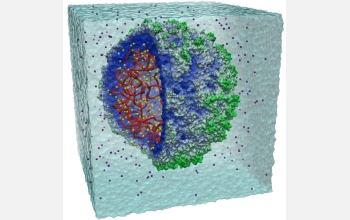|

Press Release 06-049
Supercomputer Maps One Million Atoms of a Complete Virus in First Simulation of a Life Form

Virtual virus takes 100 days on supercomputer, 35 years on a desktop
March 23, 2006
For the first time, researchers have visualized the changing atomic structure of a virus by calculating how each of the virus' one million atoms interacted with each other every femtosecond--or one-millionth-of-a-billionth of a second. A better understanding of viral structures and mechanisms may one day allow researchers to design improved strategies to combat viral infections in plants, animals and even humans.
Led by Klaus Schulten at the University of Illinois at Urbana-Champaign, the team tapped the high-performance power of the National Center for Supercomputing Applications (NCSA) processors to accomplish the task. Still, it took about 100 days to generate just 50 nanoseconds of virus activity. Schulten says it would have taken the average desktop computer 35 years to come up with the results.
The simulation revealed key physical properties of satellite tobacco mosaic virus, a very simple, plant-infecting virus. Ultimately, scientists will generate longer simulations from bigger biological entities, but to do so, they need the next generation of supercomputers, the so-called "petascale high-performance computing systems." The National Science Foundation (NSF) is currently devising a national strategy for petascale computing to give scientists and engineers the resources needed to tackle their most computationally intensive research problems.
NSF supported the work through funding to the NCSA and through a graduate research fellowship to study first-author Peter Freddolino. The National Institutes of Health also provided support for the study, which was published in the March issue of Structure.
For more information see the news releases at:
The University of Illinois at Urbana-Champaign
National Center for Supercomputing Applications
Nature
-NSF-

Media Contacts
Richard (Randy) Vines, NSF (703) 292-7963 rvines@nsf.gov
Program Contacts
Stephen Meacham, NSF (703) 292-8970 smeacham@nsf.gov
Principal Investigators
Klaus Schulten, University of Illinois at Urbana-Champaign (217) 244-1604 kschulte@ks.uiuc.edu

The National Science Foundation (NSF) is an independent federal agency that supports fundamental research and education across all fields of science and engineering. In fiscal year (FY) 2009, its budget is $9.5 billion, which includes $3.0 billion provided through the American Recovery and Reinvestment Act. NSF funds reach all 50 states through grants to over 1,900 universities and institutions. Each year, NSF receives about 44,400 competitive requests for funding, and makes over 11,500 new funding awards. NSF also awards over $400 million in professional and service contracts yearly.
 Get News Updates by Email Get News Updates by Email
Useful NSF Web Sites:
NSF Home Page: http://www.nsf.gov
NSF News: http://www.nsf.gov/news/
For the News Media: http://www.nsf.gov/news/newsroom.jsp
Science and Engineering Statistics: http://www.nsf.gov/statistics/
Awards Searches: http://www.nsf.gov/awardsearch/
| 

